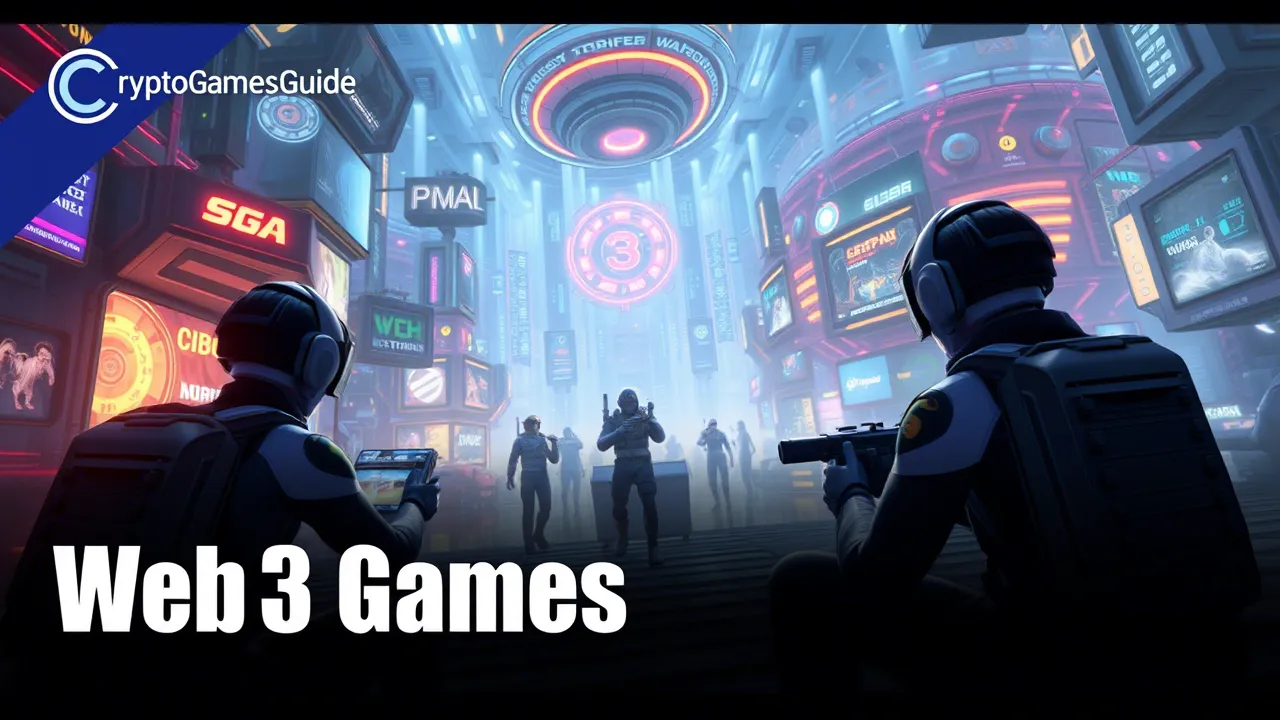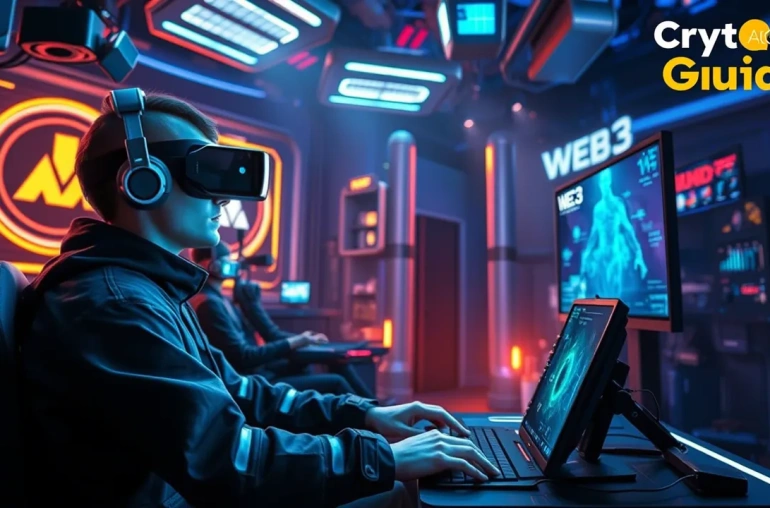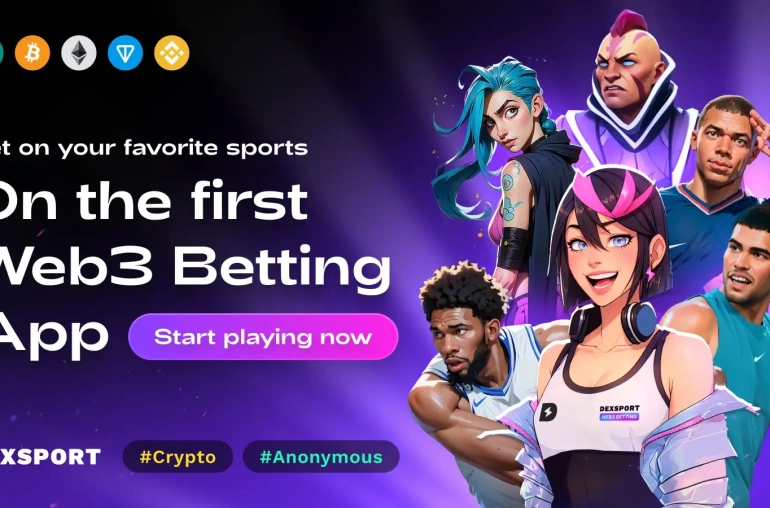Web3 gaming is set for a major jump in 2025 as studios deliver titles that blend entertainment with real rewards. Players don’t just win or lose—they earn tokens or digital assets they actually own. This new model draws in those who seek both fun and profit.
The surge builds on years of steady growth. As participation grows, opportunities for play-to-earn enthusiasts multiply. In this post, you’ll find the ten standout games offering strong earning potential in the year ahead. These picks matter for anyone who wants to stay ahead in the fast-moving play-to-earn sector.
For a clear view of how Web3 games have grown, consider the following chart:
| Year | Total Active Web3 Players (Millions) | Market Value (USD Billion) |
|---|---|---|
| 2022 | 2.5 | 3.2 |
| 2023 | 4.0 | 5.8 |
| 2024 | 6.2 | 9.5 |
| 2025* | 9.0 (est.) | 15.0 (est.) |
*Estimates based on industry projections.
If you’re looking for more on earning opportunities, check out this guide to the best crypto games that pay real money.
Web3 Gaming Trends for 2025

Web3 gaming in 2025 is building on years of innovation and gameplay upgrades, moving well beyond basic play-to-earn mechanics. Studios are focusing on richer player experiences, mainstream tech integration, and providing real digital ownership through blockchain. These trends make it clear that 2025 will not be just about earning but about redefining how players interact, compete, and create value in game worlds.
Growth of AAA-Quality Web3 Titles
Quality over quantity is now the guiding principle. In 2025, Web3 developers are releasing games that challenge the best of traditional consoles and PC. Players see:
- High-end graphics and immersive sound design.
- Deep stories and expansive lore.
- Multiplayer modes with smooth blockchain-powered transactions.
- Enhanced communities that shape in-game events.
For example, new releases like Off The Grid and Moonray stand out for their polished design and optional Web3 integrations, targeting players who want entertainment first and blockchain rewards second.
Play-and-Own and Community-Driven Economies
Play-to-earn is evolving. Many 2025 games embrace play-and-own and play-to-contribute systems:
- Players own unique NFT assets, such as weapons, skins, or custom avatars.
- Community members influence governance and economy through voting or game design contributions.
- Earning models reward skill, creativity, and participation, not just screen time.
This shift supports a fairer system where value grows with the community.
Advanced NFT and Digital Asset Integration
NFTs in 2025 Web3 games are much more than collectibles:
- Dynamic NFTs evolve as you advance—think characters or weapons that level up.
- Fractionalized assets enable shared ownership of rare items or land.
- Utility NFTs unlock exclusive content or in-game abilities.
NFT functions merge seamlessly with core gameplay, making them useful rather than just another trading token.
Interoperability Across Virtual Worlds
A defining feature for 2025 is the push for asset and identity transfers between games and worlds:
- Players carry skins, achievements, and status from one game to the next.
- Virtual goods—like vehicles or pets—move between metaverse spaces.
Interoperability supports a persistent digital presence, anchored by blockchain, and deepens engagement across titles.
Focus on Security, Scalability, and Compliance
Developers are investing heavily in security, network scalability, and meeting global regulations:
- Major games partner with reputable security firms to audit smart contracts.
- Layer-2 blockchains ease congestion, supporting millions of microtransactions daily.
- Teams design flexible compliance modules to stay updated as governments evolve crypto rules.
This focus helps attract mainstream audiences by building trust and stability.
Expansion to Mainstream Platforms
Web3 titles are entering the mainstream through console partnerships and cloud gaming:
- Select games release on PlayStation, Xbox, and cloud platforms, sometimes with opt-in blockchain features.
- Companies test limited Web3 functionality within traditional gaming stores, reaching broader markets.
This marks a major push toward adoption beyond crypto natives.
Market and Innovation Outlook
Despite a rocky market for crypto gaming tokens in early 2025, the underlying innovation continues strong. Investments in tech, player-centric economies, and genuine IP integration from major studios fuel a sense of optimism as traditional gamers show growing interest in ownership-driven and rewards-based play.
Data Snapshot: Web3 Gaming Industry Scale
Here’s a graphical view of market and player growth:
| Metric | Q1-2024 | Q1-2025 (est.) |
|---|---|---|
| Unique Active Wallets (millions) | 23.9 | 24.6 |
| Web3 Game Market Cap (USD) | $12.9B | $15.0B |
| Games with AAA Quality | 12 | 30+ |
New models, advanced ownership mechanics, and interoperability are placing Web3 gaming on track to join the mainstream in 2025. To explore more on earning and crypto gaming strategies, see the top blockchain games with the best rewards.
Top 10 Web3 Games to Play in 2025

The next wave of Web3 titles redefines what it means to earn while playing. These projects go much further than collectibles or simple markets. The games below stand out for high-quality gameplay, sustainable rewards, and strong communities. Let’s explore the top picks for 2025.
Axie Infinity: The Ongoing Evolution
Axie Infinity continues to shape the play-to-earn space by upgrading both its engine and economy. The new Axie Core and Origins modes update gameplay and reward models. Players build teams of digital pets, breed unique traits, and compete in real-time battles. With less focus on pure earning and more on skill and collection, Axie stays fresh and competitive.
Regular tournaments, seasonal challenges, and strong community governance keep Axie well ahead of older blockchain titles. For those new to the space, see this beginner’s guide to blockchain games for more on how Axie paved the way for Web3 gaming’s growth.
Illuvium: Open-World Adventure
Illuvium is an open-world RPG that brings together sweeping alien landscapes, auto-battler mechanics, and NFT-based creatures. Players hunt wild Illuvials, battle in the Arena, and collect rare genetic combinations. Each asset is owned as an NFT, meaning your strongest fighters belong to you, both in and out of the game.
The team’s consistent delivery and high production values place Illuvium at the top tier of 2025 releases. Its cross-layer technology supports smooth transactions and real-time PVP, giving players freedom to explore, compete, and earn well into the next year.
Big Time: Action RPG for Collectors
Big Time merges hack-and-slash action with a time-traveling twist. Players team up in dungeons, collecting unique armor and gear as digital assets. Each run yields rare drops—sometimes as tradable or upgradeable NFTs, sometimes as cosmetic badges for bragging rights.
Big Time keeps engagement high with persistent updates and a player-owned economy. Rare items and timed events encourage both solo explorers and group strategists, making it a top choice for those seeking both action and earning potential.
Star Atlas: Space Exploration and Strategy

Star Atlas stands out for its galaxy-scale ambition. Players command fleets, mine asteroids, and build outposts among the stars. Each ship, crew member, and resource is a digital asset, letting you build, trade, and wage war for profit.
The project combines real-time strategy, diplomacy, and economic management, all tracked on-chain. Star Atlas’s community alliances and regular updates ensure gamers always have new territory to explore and stake.
Guild of Guardians: Team-Based Strategy
Guild of Guardians makes mobile strategy social and profitable. Players form guilds and coordinate to build unbeatable teams. Each hero is a distinct NFT, letting you assemble squads with unique strengths for raids and events.
Daily quests, crafting, and trading benefit both grinders and casuals. Earning flows from regular play, and the game’s “guild” model incentivizes teamwork—profits are higher when you work together. Expect tournament ladders and seasonal rewards in 2025 as adoption grows.
The Sandbox: Creator-Driven Metaverse
The Sandbox lets users own, build, and monetize virtual worlds. This voxel-powered platform blends game making, social hubs, and thriving NFT marketplaces. Players create assets or experiences, then share or sell them through the game’s marketplace.
Major brands, indie creators, and players build side-by-side, leading to a diverse world with endless opportunity. Owning land unlocks the full suite of tools; creators can turn ideas into income streams through shops, concerts, or even on-platform mini-games.
DeFi Kingdoms: Pixel NFT DeFi
DeFi Kingdoms stands out for its pixel art and DeFi-powered mechanics. The game combines role-playing quests and NFT heroes with a thriving decentralized finance ecosystem. Players grow heroes, farm tokens, and trade materials, blending gaming with real-world DeFi tools.
Each quest or harvest operation comes with clear reward odds and transparent outcomes. For those interested in how NFTs and yield farming blend in gaming, DeFi Kingdoms is both a fun title and an innovative financial playground.
Shrapnel: AAA Extraction FPS
Shrapnel delivers a first-person shooter experience with blockchain-powered asset ownership. Its AAA-grade graphics and player-driven economy set a high watermark for Web3 shooters. Gamers drop into war zones, extract resources, and secure rare loot—all as digital assets that can later be traded or kept.
Mod tools and seasonal tournaments further elevate engagement, while its boundary-pushing design appeals to both esports veterans and those new to blockchain shooters.
Otherside: Bored Ape Metaverse
Otherside transports NFT holders into an interactive, 3D universe linked to the Bored Ape Yacht Club ecosystem. Users explore, build, and own digital land, each plot supporting unique events and assets.
The open-world approach encourages both solo play and community ventures. Upcoming live events and high-profile partnerships will keep the Otherside metaverse lively and rewarding long-term.
Pixelmon: Community-Driven Monster Collection
Pixelmon reimagines the monster-battling genre for Web3, driven by active feedback from its fanbase. Players hunt, capture, and train monsters—each a distinct NFT with evolving skills. The game broadens its world through regular content drops and community votes on new monsters or mechanics.
Earnings come from tournaments, trades, and unique item drops. Pixelmon’s transparency and commitment to community-driven design set a strong example for crowd-powered games coming in 2025.
How to Earn in Web3 Games
Playing Web3 games in 2025 goes far beyond collecting points. These games offer real cryptocurrency, NFTs, and even control over game economies. Anyone can find a style that fits, from casual players to serious competitors. As in any new technology, knowing how to earn is key to getting the most from your time in these virtual spaces.
Main Earning Pathways in Web3 Games
Web3 games support multiple ways to earn, often blending several systems. Understanding these will help you spot the best fit for your interests.
- Play-to-Earn Rewards: Players earn tokens or NFTs by completing PvP matches, finishing story missions, or reaching in-game milestones.
- Staking and Yield Farming: Some titles let you lock tokens or in-game assets to generate rewards over time, similar to how DeFi works.
- Trading Digital Assets: Players trade rare items, land, or characters on in-game marketplaces for profits.
- Tournaments and Events: Competitive players can join events with prize pools paid in cryptocurrency, drawing both pros and casuals.
- Creator Economies: If a game has design tools, you can build and sell assets, skins, or even custom levels for profit.
Each earning stream also brings different risks and potential rewards. Balancing immediate wins with long-term gains is important for sustained growth.

In-Game Currencies and Assets
Most Web3 games operate on cryptocurrencies or tokenized points, moving value seamlessly between platforms. These tokens are often paired with NFT assets, making in-game progress both measurable and tradable.
Typical assets include:
- Tokens (ERC-20 or similar): Used for purchases, upgrades, or payouts. Some hold value across partner games.
- NFTs (ERC-721/1155): Unique items like skins, heroes, weapons, or land that you can own, trade, or upgrade.
Ownership powers the earning concept—what you find or achieve is truly yours and has value beyond the game.
The Role of Marketplaces
Most top Web3 games include their own secondary marketplaces. Here, players list and buy rare items, boosting both liquidity and the potential for profit. Many also connect with popular third-party trading platforms, giving assets real-world exposure. High-demand assets often see significant value spikes, especially for limited edition content.
For a deeper review of how economic systems shape play and earning potential, see the expert breakdown of Best Web3 Games.
Guilds, Teams, and Contribution Earnings
Web3 gaming puts a premium on teamwork. Guilds pool resources for larger profits, with members sharing rewards from raids, tournaments, or collective staking. This system makes group play rewarding and aligns incentives for active participation. Many games even add governance rights, so your activity helps shape the project’s future.
Early Access and Airdrops
Top projects often reward early players. Joining a Web3 game at launch can mean access to exclusive NFTs, legacy tokens, or airdrop campaigns. These rewards frequently gain long-term value, giving a first-mover advantage to early adopters who stay active.
Earning Potential: Data Snapshot
Here’s how earning opportunities can break down across mainstream Web3 titles:
| Revenue Type | Example Activity | Typical Monthly Earnings* |
|---|---|---|
| Play-to-Earn Quests | Battles, challenges | $20 – $500 |
| Asset Trading | NFT sales, land deals | $50 – $2,000+ |
| Staking/Yield | Token staking, liquidity | $5 – $150 |
| Tournaments/Leaderboard | Competitive play | $100 – $10,000+ |
*Earnings vary by game, market, and player effort.
For more on mechanics, player spending, and earning styles, explore the comparison of Crypto Casinos vs Web3 Platforms.
Tips to Maximize Earnings
Generating real value from Web3 games demands strategy and some due diligence:
- Research each game’s model—play before investing.
- Stay updated on limited events and seasonal rewards.
- Network with active communities, guilds, or social channels.
- Use secure wallets and never share private keys.
- Track NFT values and trading trends for timely sales.
If you’re serious about building sustainable earnings, tap into Gaming Guides and Tips to understand market cycles, tokenomics, and safe practices.
The best Web3 games of 2025 reward smart play, teamwork, and timing—which means every player can find the earning model that fits them best.
Conclusion
Play-to-earn in Web3 games continues to attract attention as players seek value beyond entertainment. The surge in participation and innovative features speak to a maturing space, where real digital ownership and earning opportunities take center stage. Keeping up with changes is key—monitoring updates, joining active communities, and tracking new projects will help you stay ahead.
To explore more top choices in this growing sector, see the expert-curated list of Best Crypto Games, which is updated regularly.
Your decisions today shape future outcomes as Web3 gaming advances. Thank you for reading—and consider sharing your experiences or joining discussions to drive the next phase of this industry.


